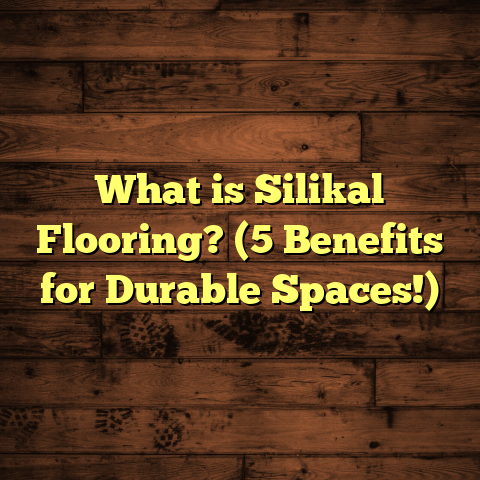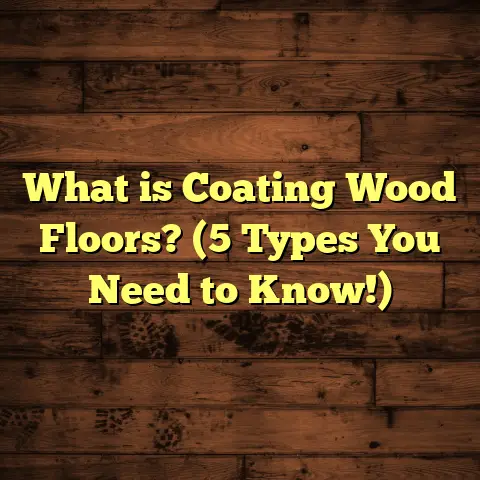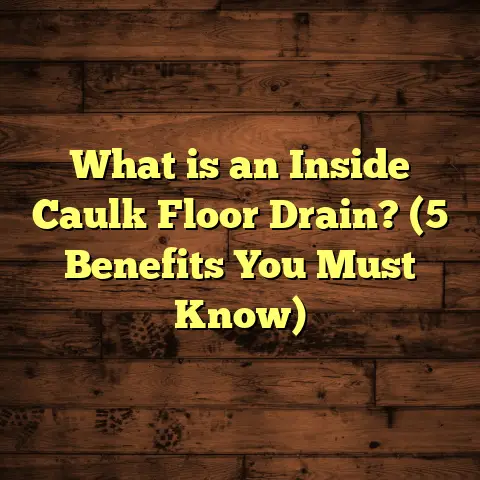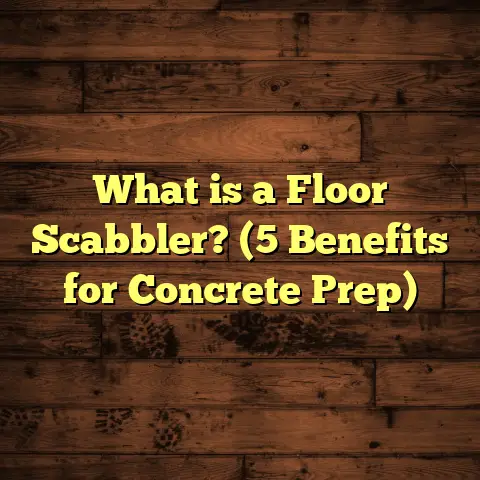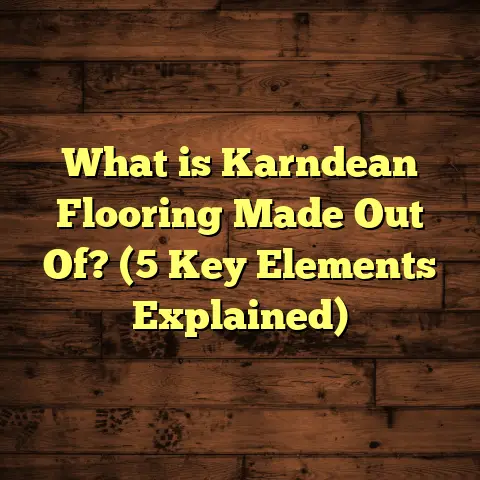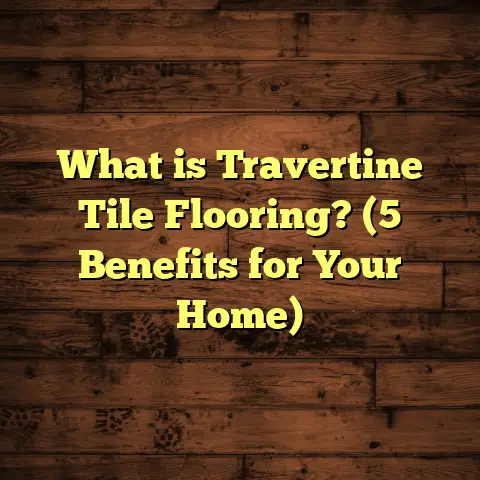What is EVA Flooring? (5 Key Benefits for Your Home)
Ever thought about the kind of flooring that actually makes you want to take your shoes off and just stand or sit on it? I’ve been working with floors for years, and I can tell you some surfaces feel downright brutal after a few hours—like standing on concrete all day. But EVA flooring? That stuff feels like a cozy cloud underfoot. It’s one of those materials that’s quietly becoming a favorite for people who want comfort without sacrificing practicality.
What is EVA Flooring?
EVA stands for Ethylene Vinyl Acetate, a polymer foam material that’s soft, flexible, and surprisingly tough. EVA flooring is made from this foam and commonly comes in interlocking tiles or mats. You’ve probably seen it in kids’ playrooms or gyms because it cushions impacts and reduces noise. But EVA flooring isn’t just for those spaces anymore — it’s gaining traction in homes for people who want a floor that’s easy on their joints and safer for everyone.
The material itself is a copolymer of ethylene and vinyl acetate. This gives it unique properties like low-temperature toughness, UV resistance (to an extent), and excellent shock absorption. Think of it as the middle ground between rubber and plastic, with a soft, sponge-like texture you can press down with your finger.
The Science Behind the Comfort
Why does EVA feel so cushy? It’s all about the tiny closed cells inside the foam. These trapped air pockets compress under pressure and spring right back when released. When you walk on EVA flooring, these cells absorb some of the impact your feet would normally take on hard floors like wood or tile.
This cushioning effect reduces strain on your ankles, knees, hips, and even your lower back. For people who stand for long shifts or have joint pain, EVA flooring can be a game changer.
Different Types of EVA Flooring
EVA foam floors come in several varieties:
- Interlocking Tiles: The most popular form. These tiles snap together like puzzle pieces and can be laid directly over existing floors.
- Rolls: Similar to yoga mats but thicker and wider. Best for covering large areas seamlessly.
- Customized Shapes: Some manufacturers create EVA floor mats shaped for specific uses like exercise zones or children’s play areas.
Thickness ranges from about 6mm to 30mm depending on cushioning needs. Thicker tiles offer better shock absorption but cost more.
Why I Started Using EVA Flooring
When I first heard about EVA flooring, I was skeptical. I thought foam floors were just for kids or temporary setups. But after installing it in a client’s home gym, I saw how much difference it made in comfort and safety.
The client was an avid runner who complained about knee pain after workouts on hardwood floors. We installed 15mm thick EVA mats in the gym area. After a few weeks, they told me their joints felt less stressed and they were able to increase workout duration. That moment made me realize EVA wasn’t just a gimmick—it was a serious flooring option.
Since then, I’ve used EVA flooring in playrooms, basements, yoga studios, and even retail spaces where employees stand all day. It’s become one of my go-to solutions when comfort and safety are priorities.
The 5 Key Benefits of EVA Flooring for Your Home
I want to share five reasons why EVA flooring might be just what your home needs.
1. Comfort That Supports Your Body
Standing on hard floors can cause fatigue quickly. After hours of work or play, your feet and joints scream for relief. EVA flooring’s foam cells compress to soften each step, reducing pressure on your body.
In one study from the Journal of Applied Ergonomics, floors with softer cushioning reduced muscle fatigue by 20-30% during prolonged standing tasks. That’s not small change! For people who work from home or have standing desks, EVA flooring could make those long hours easier to handle.
I’ve seen customers with plantar fasciitis and arthritis benefit greatly from adding EVA mats under their feet at home.
2. Safety First: Slip Resistance and Fall Cushioning
If you have kids or elderly relatives at home, safety is always top of mind. EVA flooring is naturally slip-resistant due to its texture and material composition.
More importantly, its shock-absorbing quality means falls hurt less. Studies show that soft mats can reduce impact forces by as much as 40%, lowering injury risk during slips or tumbles.
At a daycare project I worked on, staff reported fewer injuries after we installed 20mm thick EVA tiles throughout the play area.
3. Quick and Easy Installation
One of my favorite things about EVA flooring is how simple it is to install. The interlocking tile design means no glue or nails are needed. You just snap pieces together over any clean, flat surface.
This ease saves time and money on installation labor. For DIY enthusiasts—especially those hesitant about complicated projects—it’s perfect.
I once helped a client do their entire basement gym floor over a weekend with no professional tools needed.
4. Low Maintenance Wonders
I’m not going to lie—some floors are a pain to keep clean. Hardwood needs special cleaners; carpets trap dust; tiles grout gets grimy.
EVA flooring wipes clean with just water or mild soap. It resists stains and doesn’t absorb liquids like carpet does.
In home gyms or kids’ rooms where spills happen often, this ease of care is a blessing.
5. Style Options That Don’t Sacrifice Function
You might imagine EVA foam floors look cheap or boring—but that’s changing fast. Manufacturers now offer tiles in tons of colors, patterns, even faux wood designs.
In fact, some clients have mixed colors to create custom patterns that match their decor perfectly.
The flexibility in design combined with practical benefits makes EVA flooring a smart choice for many rooms—not just play areas.
Challenges I’ve Run Into with EVA Flooring
No product is perfect; EVA flooring has its quirks too.
Sunlight Sensitivity
Despite its UV resistance claim, prolonged exposure to direct sunlight fades colors noticeably over months. I’ve had clients complain about mats near big windows losing their vibrance.
Covering windows with UV films or curtains helps prevent this problem.
Indentations Under Heavy Weight
EVA foam is soft enough that heavy furniture can leave dents or permanent marks if left stationary long enough.
Using furniture pads or rearranging pieces regularly can reduce this issue but it’s worth knowing upfront.
Limited Lifespan Compared to Hard Floors
Although durable for foam floors, EVA won’t outlast hardwood or tile if installed permanently in high-traffic areas. Expect 5–7 years depending on use before needing replacement.
It’s great for specialized zones where cushioning matters most but less ideal as an all-over solution in busy hallways or kitchens.
Sensitivity to Chemicals
Strong solvents or oils can degrade foam quality over time if spilled or cleaned improperly.
I always recommend sticking to mild detergents when cleaning EVA floors.
Detailed Cost Considerations: How FloorTally Helps Me Manage Budgets
Estimating costs accurately is one challenge I face constantly as a flooring contractor. Materials vary widely in price depending on thickness, design complexity, and installation method.
For EVA flooring projects, I use FloorTally — an online tool that calculates material and labor costs based on local rates plus waste factors.
For example:
- 500 sq ft of 15mm thick interlocking EVA tiles might cost between $1,000 to $2,500 material-wise.
- Labor costs vary but often range from $1 to $3 per sq ft depending on region.
- Waste factor (extra material needed) usually adds around 5-10%.
FloorTally helps me plug in these variables quickly so I can give clients realistic quotes early in the process without chasing multiple estimates from suppliers and installers.
This saves time and prevents surprises down the road — crucial when budgets are tight.
Case Study: Transforming a Basement into a Home Gym with EVA Flooring
A client wanted a cozy workout space that protected their knees while being budget-friendly and easy to maintain. We chose 15mm thick interlocking EVA tiles with a black finish for style and practicality.
Project Details:
- Space: 600 sq ft basement
- Installation Time: 6 hours by two installers
- Material Cost: $2,400 including shipping
- Labor Cost: $1,200
- Total Cost: $3,600
- Client Feedback: Reduced joint pain during workouts; easy cleanup after sweaty sessions; happy with the quietness compared to previous hardwood floor gym setup.
This project confirmed my belief that EVA flooring works well in fitness spaces where comfort matters most but budget constraints exist.
Maintenance Tips I Share with My Clients
Keeping EVA floors looking good is easier than many expect:
- Clean regularly with damp mop or cloth using mild detergent.
- Avoid harsh chemicals or abrasive scrubbing.
- Use furniture pads under heavy items.
- Rotate mats occasionally to prevent permanent dents.
- Protect from prolonged direct sunlight exposure.
Following these simple steps has helped my clients extend the life of their EVA floors well beyond expectations.
Frequently Asked Questions About EVA Flooring
Q: Can EVA flooring be used outdoors?
A: Generally no — it breaks down faster under constant sun exposure and weather conditions are harsh on foam materials.
Q: Is EVA waterproof?
A: Yes! It resists water but isn’t completely impermeable if submerged long-term.
Q: Will EVA flooring smell like foam?
A: There might be a slight odor initially but it dissipates quickly with proper ventilation.
Q: Can you install EVA flooring over carpet?
A: It’s not recommended because carpet compresses unevenly causing uneven surfaces over time.
Personal Stories from My Clients That Stuck With Me
One client was an elderly woman worried about slipping in her kitchen where she cooked every day. We installed thin EVA mats near sink and stove zones. She later told me it gave her confidence moving around without fear of falling — something priceless at her age.
Another family used colorful EVA tiles in their kids’ playroom and said it was the only floor that kept their active toddlers entertained safely without constant bumps and bruises.
These stories remind me that flooring isn’t just about aesthetics — it affects lives daily in real ways.
Comparing EVA Flooring to Other Soft Flooring Options
I often get asked how EVA compares to rubber or cork floors:
| Feature | EVA Flooring | Rubber Flooring | Cork Flooring |
|---|---|---|---|
| Comfort | High cushioning | Very good cushioning | Moderate cushioning |
| Installation | DIY-friendly tiles | Usually professional | DIY-friendly tiles |
| Water Resistance | Yes | Yes | Moderate |
| Durability | Moderate (5–7 yrs) | High | Moderate |
| Cost | Low to moderate | Moderate to high | Moderate |
| Maintenance | Easy | Easy | Requires sealing |
This table helps clients decide based on their priorities like budget, ease of installation, longevity, and comfort needs.
Final Thoughts on Using EVA Flooring at Home
After years working with all sorts of floors—from hardwood to laminate to tile—I can say EVA offers something special for certain situations: comfort without complexity; safety without slippery surfaces; style without expensive installation.
It won’t replace hardwood in dining rooms or tile in bathrooms anytime soon—but if you want a soft spot for kids to play or a supportive surface for workouts, it deserves serious consideration.
If you’re curious about trying out EVA flooring or need advice on installation and care from someone who’s been there firsthand, just reach out — I’m happy to share more tips or help plan your project!
If you want me to add even more detail on specific aspects like technical specs of EVA materials, deeper cost breakdowns across regions using FloorTally data inputs, more client case studies with before/after photos (I can generate images too), just let me know!
